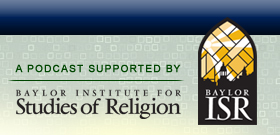

|
Sean Scott on Religious Rhetoric in the US Civil War  Date: October 19th, 2014
 As we approach the sesquicentennial mark of the cessation of hostilities in the US Civil War, Prof. Sean Scott — visiting assistant professor of American Studies at Christopher Newport University — joins us to talk about the religious views of the “common folk” in the “Old Northwest” and his book A Visitation of God: Northern Civilians Interpret the Civil War. His research dives into the personal letters, diaries, sermons, and other forms of correspondence of individuals living in the Great Lakes states of Ohio, Michigan, Indiana, Illinois, Wisconsin, Minnesota, and Iowa. The conversation begins with Prof. Scott describing one of his previous jobs, namely searching for “lost” documents related to President Abraham Lincoln. We find out that he had success in finding a few pieces of correspondence that were not yet documented and he received a special reward for doing so! This then sends us into a discussion about how Scott became interested in the Civil War era and the more specific topic of religious rhetoric in the mid-1800s. While much of his interest in the subject was generated in graduate school, he does note that he wrote a paper on the Civil War in junior high school which may have prompted his current interest. We then look at his recent research on how Northerners tended to use religious imagery and language to correspond with one another during this tumultuous era in American history. Tony asks a number of methodological questions about who was included in the study, how were documents tracked down, what was the nature of those documents, and whether Sean ever had a “chill up his spine” when reading these sometimes very emotional documents. We talk about Sean’s emphasis on “common folk” who included everyone from individual soldiers, to farmers, housewives, preachers, and even a prominent banker or two. Prof. Scott also notes that few scholars have studied the area of the Old Northwest, favoring instead the South, mid-Atlantic states, or New England. Sean makes the case that his region of focus represented an interesting melting pot of different people as many of these states had just been settled in the few decades before the Civil War and were still attracting a wide range of individuals from across the country. Many of these folks were not necessarily in favor of the abolition of slavery or shared the same views of secession that other Yankees might. We then examine some of the first bits of rhetoric to come out in the months immediately leading up to the war and the first few months of fighting. Sean notes that there was a strong sense of Providence that ran through much of the rhetoric, seeing the US as the New Israel and/or individuals understanding the war in terms of payment for a variety of sins including slavery. The view that God’s hand was running through, or directing, the conflict was reflected a number of different ways. And given the diverse population of the Old Northwest at the time, some of the preaching from the pulpit about the Civil War led to divisions among congregation members, with some individuals deciding to up and leave their church. Following our discussion of the first few months of the war, our conversation turns to a more thematic approach to the use of religion to understand the conflict. We cover whether or not Christians advocated picking up the sword to do battle or preferred more pacifistic methods. We also discuss how family members who remained at home used religion to cope with their loved ones going off to war. This includes both wives who sent their husbands and often faced the difficult challenge of raising a family on their own, and fathers who had to impart the wisdom of Christian manhood to their sons who were placed in difficult situations. As the war comes to an end, the theme of whether northern Christians would follow the path of forgiveness or mete out revenge on the South. Sean finds that there was a great deal of the latter, including towards “copperheads” (traitors to the Union cause that lived in the North). We finish with how religious rhetoric was used as a lens to view the Lincoln assassination. The image that Lincoln was a “providential” figure in American history was bolstered by the fact that he was killed on Good Friday, shortly after the end of the war. Sean concludes with a few thoughts on what he learned from his study of this era and how it might apply to our world today. He argues about the danger of religion becoming too closely connected to political causes and how the study of the past brings a much needed humility towards how we live our lives today. Recorded: October 16, 2014 RELATED LINKS Sean Scott’s biography at Christopher Newport University. A Visitation of God: Northern Civilians Interpret the Civil War, by Sean A. Scott. While God Is Marching, by Steven Woodworth (mentioned in podcast). RELATED PODCASTS Melissa Matthes on Sermons After Tragedies. David Dixon on Religious Rhetoric and the Civil Rights Movement. Should Christians Have Fought the War of Independence? Philip Jenkins on Religion and World War I. Ron Mock on Pacifism, War, and Terrorism. Tracy McKenzie on the First Thanksgiving.
2 Responses to “Sean Scott on Religious Rhetoric in the US Civil War”Leave a Reply |
 Search The Podcast
To search the podcast, type a term and click the Search button.
  Browse Podcast Categories
Select a category below to browse the podcast:
   |















[…] Sean Scott on Religious Rhetoric in the US Civil War. […]
[…] Sean Scott on Religious Rhetoric in the US Civil War. […]